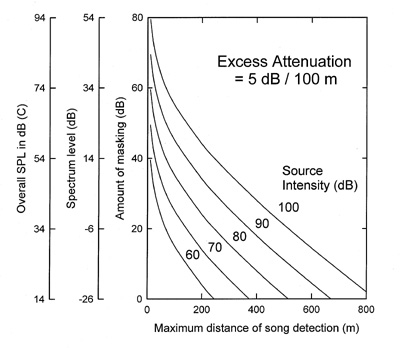The Effects of Environmental Noise on Communication in Birds
When noise masks the biologically important signals of birds in the wild, and interferes with their ability to communicate effectively, it surely has a detrimental effect on their normal behavior and breeding biology. We know much about the hearing sensitivity of birds from laboratory tests with simple stimuli, but almost nothing about how they perceive the vocalizations of their own species in noise. Laboratory data on the effect of noise on the masking of tones can be combined with the scattered information available on other factors influencing the distance over which biologically meaningful signals can be used under natural conditions, such as the location and source intensity of a singing bird, the sound-attenuating and masking characteristics of the environment, and the location and hearing sensitivity of the bird receiving the signal. From such data we can obtain a rough estimate of possible communication distance, but without more information we have only a very crude idea of the effect of environmental noise on the perception of vocal signals in nature. There are virtually no data published on the effects of different types of noises (e.g. traffic or aircraft noises) on the perception of species-specific vocalizations. Such laboratory data are critical for understanding the effect of noise on acoustic communication and for developing reasonable guidelines for noise abatement.
-
Many of the major factors determining how far away a sound can be heard
have been identified in a preliminary way, including source location and
intensity, inverse square attenuation with distance, excess attenuation,
spectrum level of the background noise, and the receiver's location and
auditory sensitivity. Taken together these factors form the basis for a
crude algorithm that may be used to predict how environmental noise will
influence a particular species' ability to detect a sound in the
environment. An example of how such an algorithm might be used is given in
the accompanying figures for the song sparrow (Melospiza melodia).
These figures are based on a simplified (and somewhat unnatural) measure of
masking of pure tones by broadband (white) noise and serve to illustrate how
such a model may be developed. Ultimately, however, data incorporating bird
thresholds for the detection, discrimination, and identification of natural
vocalizations in traffic or aircraft noise would be needed in order to
provide an accurate representation of noise effects on communication
abilities.

The figure at right illustrates the theoretical maximum distance that one
song sparrow can detect the song of another bird in this species. The
dependent variables represented here are different source intensities,
assuming an excess attenuation of 5 dB/100 m. Background noise level is
given as overall SPL (C-weighted), spectrum level (per cycle energy
distribution over the entire band of noise), and the amount of masking
assuming a critical ratio of 26 dB (as measured in the laboratory). We know
from laboratory studies that the threshold in the quiet for a 2 kHz pure
tone is about 0 dB SPL for song sparrows. Critical ratio data for this
species shows that background noise levels must be at least 26 dB below the
power in a 2 kHz pure tone in order for the tone to be detected by song
sparrows (Okanoya
& Dooling 1988, 1990). Thus, for a noise spectrum level
(energy per Hertz) of -26 dB, masked threshold is the same as absolute
threshold in the quiet, and no masking occurs. If the spectrum level of the
background noise is 0 dB SPL, however, the threshold of the signal is raised
to 26 dB SPL, causing 26 dB of masking. The spectrum level of the background
noise can be calculated from the overall sound pressure level, and depends
on the bandwidth and distribution of the noise. For a typical sound level
meter reading of noise in the frequency band 0 - 10 kHz, an overall SPL of
40 dB is equivalent to a spectrum level of about 0 dB if the noise is flat.
